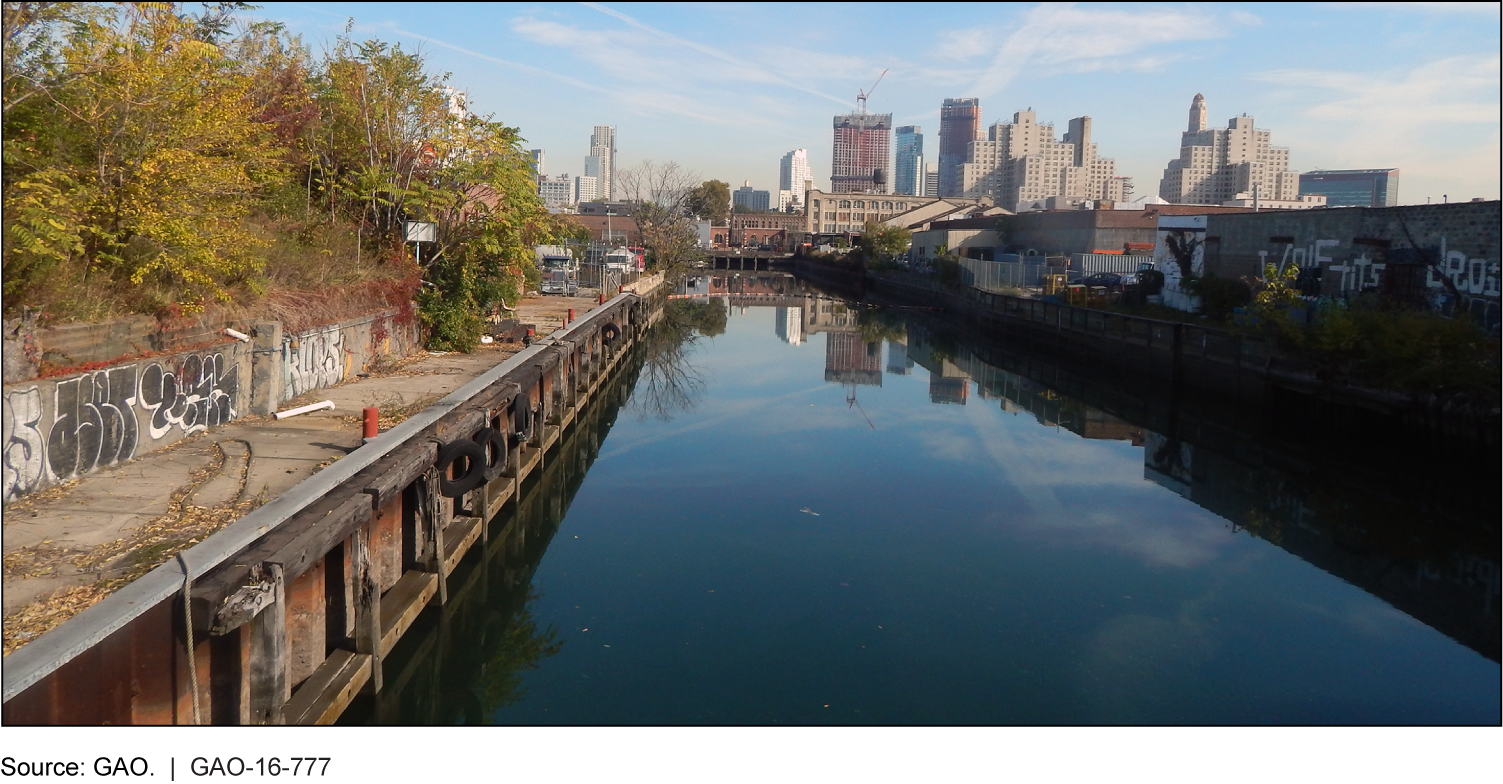Superfund Sediment Sites: EPA Considers Risk Management Principles but Could Clarify Certain Procedures
Fast Facts
Bodies of water across the United States can contain sediments contaminated with toxic chemicals, heavy metals, sewage, and other hazardous substances. EPA's Superfund program is the principal program for cleaning up sediment sites.
This report examines EPA's process for managing Superfund sediment sites more consistently nationwide, and looks at the challenges EPA faces in managing cleanups.
The recommendation we made could help ensure consistency in the information EPA receives from its regional offices about Superfund sediment sites.
Gowanus Canal Superfund Sediment Site, Brooklyn, NY

Photo of a Superfund sediment site
Highlights
What GAO Found
The Environmental Protection Agency (EPA) established risk management principles and a consultation process to help provide national consistency in its management of Superfund sediment sites. Specifically, EPA developed a framework of 11 risk management principles, including assessing sources of contamination and ways to control them early in the cleanup process, that EPA regional officials are to consider in developing a site's cleanup remedy. EPA also established a consultation process between EPA's headquarters and 10 regions for two tiers of sediment sites—Tier 1 sites, those with proposed cleanups of 10,000 cubic yards or more of contaminated sediment, and Tier 2 sites, those that are large, complex, or controversial. As part of the consultation process for Tier 1 and Tier 2 sites, regional officials are to prepare and submit consideration memorandums to headquarters to document how the 11 principles are being considered as the region develops a cleanup remedy for each site. Additionally, for Tier 2 sites, EPA established the Contaminated Sediments Technical Advisory Group (CSTAG) to monitor the progress of and provide advice on sites throughout the cleanup process. The CSTAG is to review the consideration memorandums for Tier 2 sites and meets with regional staff as part of the consultation process. CSTAG is to provide recommendations to regions on their proposed cleanup approach, and regional staff are to provide written responses to CSTAG recommendations.
EPA generally followed its steps for providing national consistency in its management of Superfund sediment sites at selected Tier 1 and Tier 2 sites GAO reviewed. At 5 of 6 Tier 1 sites reviewed, regional officials submitted memorandums explaining how the 11 principles were considered in developing the cleanup remedy. At 11 of 12 Tier 2 sites reviewed, officials submitted consideration memorandums prior to their initial meeting with CSTAG; CSTAG provided recommendations on the regions' consideration of the principles, and regional officials provided written responses, as required in CSTAG's operating procedures. At 5 of the 12 Tier 2 sites where CSTAG held additional meetings, or update meetings, consideration memorandums were not submitted to CSTAG. CSTAG's operating procedures do not clearly describe what type of information and documentation, if any, should be prepared by regional officials and provided to CSTAG in advance of these meetings. Under federal standards for internal controls, agencies are to clearly document internal controls, such as in operating manuals. Clarifying, in the operating procedures, the types of information and documentation, if any, that should be prepared for CSTAG before update meetings would help to ensure that CSTAG was getting information needed to inform its reviews and meetings.
EPA faces two main challenges in managing cleanups of Superfund sediment sites—technical complexities and stakeholder involvement—according to EPA officials. Technical complexities include site characteristics and the use of sampling and modeling in developing a cleanup remedy. Challenges with stakeholder involvement include the differing opinions and competing interests of stakeholders—such as communities, local governments, and industry—and the varying levels of knowledge among these stakeholders about the Superfund process, which officials said can take EPA time and resources to address.
Why GAO Did This Study
Water bodies in the United States, including rivers and harbors, may contain contaminated sediments that pose risks to ecosystems and human health. The federal government's principal program to clean up hazardous waste sites, including sediment sites, is EPA's Superfund program, authorized by the Comprehensive Environmental Response, Compensation, and Liability Act. Recently estimated costs for cleanups of some large Superfund sediment sites have ranged from about $500 million to $1.4 billion, according to EPA documents.
GAO was asked to review issues related to Superfund sediment sites. This report examines: (1) the steps EPA has taken to help provide national consistency in its management of Superfund sediment sites; (2) the extent to which EPA followed these steps at selected Superfund sediment sites; and (3) the challenges EPA officials said the agency faced in managing cleanups of Superfund sediment sites. GAO reviewed applicable laws, regulations, and guidance; a nonprobability sample of 6 of the 71 Tier 1 and 12 of the 17 Tier 2 Superfund sediment sites; and EPA documents from selected sites. GAO interviewed EPA officials and representatives of two stakeholder groups.
Recommendations
GAO recommends that EPA clarify CSTAG's operating procedures for the type of information and documentation, if any, that should be prepared for CSTAG in advance of update meetings. EPA agreed with GAO's recommendation.
Recommendations for Executive Action
| Agency Affected | Recommendation | Status |
|---|---|---|
| Environmental Protection Agency | To ensure that CSTAG's information needs are met for update meetings, the EPA Administrator should direct CSTAG to clarify, in its operating procedures, what type of information and documentation, if any, should be prepared by regional offices and provided to CSTAG members in advance of these meetings. |
Closed – Implemented
EPA concurred with our recommendation, stating that it will revise the Contaminated Sediments Technical Advisory Group (CSTAG) operating procedures to clearly describe the types of information and data that regional offices need to provide before update meetings. In January 2017, EPA updated the CSTAG operating procedures to clarify that regional offices do not need to provide a revised consideration memo for update meetings.
|
